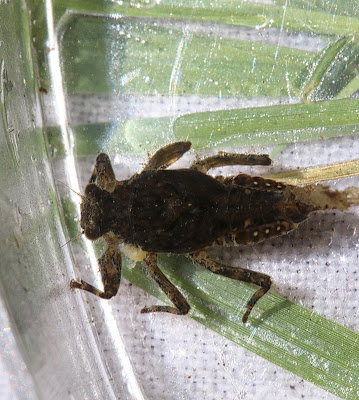Please keep in mind that any observations I have at this time are provisional. Beaty lists the names of 17 species that are found in North Carolina, noting that most are undescribed. I'd better cite him:
"North Carolina has very high diversity of Perlesta, most of which are currently undescribed in the immature stage. While many nymphs appear highly freckled some nymphs have few or inconspicuous freckles. ... It is not uncommon to get 2-3 nymphal habitus forms at one site."
("The Plecoptera of North Carolina," p. 49 in the latest version -- 4.0, 2015) He also notes that the famed entomologist Bill Stark will publish this year a
Perlesta key, but he advises us not to use it "as it contains only 6 of the 17 regional species."
So, we can forget about attempting any species ID. My goal this month is a simple one -- to identify features that appear to me as likely to related to species distinctions. So far, I've noticed three. They are: 1) the density and size of the "freckles" we see on a nymph (these black dots are the pigmentation at the base of the setae on this very setose taxon); 2) the color of the ocellar triangle, and 3) the nature of any anterior extension from the pale "M" on the head.
Thus, with the nymph at the top of the page -- one that I found in the Rivanna River in June, 2011 -- the freckles are dense and large.
On the head, the ocellar triangle is filled in and setose, the "M" pattern is interrupted, and there is no anterior extension.
I might also note that this nymph is unusally dark -- abdomen and head -- the darkest
Perlesta I've seen.
For a nymph that appears totally different, let's look at the nymph I found in Sugar Hollow last week.
The abdomen is lightly freckled and the black dots appear to be small.
And on the head, the ocellar triangle is noticeably pale and devoid of setae, the "M" is well-defined, and there is a well defined anterior projection from the middle of the "M".
There is something else we can see on this nymph that may be important. On terga 9 and 10, we can detect a faint, dark line laterally on those segments. While that line here is indistinct, it is very clear on other
Perlestas I've found.
________________
Looking at those 3-4 traits, let's see what I've found in the
Perlesta photos I've archived over the years.
I. nymphs that are densely freckled
1. Buck Mt. Creek, May 28th of this year
Very speckled and the dots are large. And note the lateral abdominal lines -- they are visible on all of the tergites, curving inward on 8 and 9, then moving slightly back to the side on 10.
On the head, the ocellar triangle is filled in with dark spots/setae, and it looks to me like the "M" extension absent.
2. Rivanna River, 7/8/14
Dramatically freckled. No real "M" pattern visible though there is a pale space at the front of the head. And, if you look closely, you can easily see the lateral, abdominal lines.
3. Lynch River, 6/6/12
and 4. Doyles River, 5/23/12, one that's fully mature
_________________
II. Well defined anterior extension, freckles light
1. the nymphs that I'm finding in the small streams in Sugar Hollow, the one that we've posted above, and this one
2. from the Doyles River, 6/23/11 (though note that on this one, the ocellar triangle is filled in/setose.
________________
III. anterior projection blurred or missing
1. Buck Mt. Creek, 6/11/16
Note the head. Not sure we can call that an "M" since the middle broadly extends to the front of the head.
Again we can see the lateral abdominal lines.
2. Buck Mt. Creek, 6/3/11, one that's completely mature
3. another that was completely mature, 6/14/13, Doyles River
4. to this "type" we can add the nymph from the very top of the page.
_________________
Well, it's a beginning. All I can do at this time is work to discern traits that
might be significant in establishing species ID. I may or may not have picked out critical things. Hope that some day we'll know one way or the other.





















































